SanDisk Extreme II Review (480GB, 240GB, 120GB)
by Anand Lal Shimpi on June 3, 2013 7:19 PM ESTRandom Read/Write Speed
The four corners of SSD performance are as follows: random read, random write, sequential read and sequential write speed. Random accesses are generally small in size, while sequential accesses tend to be larger and thus we have the four Iometer tests we use in all of our reviews.
Our first test writes 4KB in a completely random pattern over an 8GB space of the drive to simulate the sort of random access that you'd see on an OS drive (even this is more stressful than a normal desktop user would see). I perform three concurrent IOs and run the test for 3 minutes. The results reported are in average MB/s over the entire time. We use both standard pseudo randomly generated data for each write as well as fully random data to show you both the maximum and minimum performance offered by SandForce based drives in these tests. The average performance of SF drives will likely be somewhere in between the two values for each drive you see in the graphs. For an understanding of why this matters, read our original SandForce article.
If we look at the raw random read/write speed, SanDisk does fairly well but not quite to the level of Samsung's SSD 840 Pro.


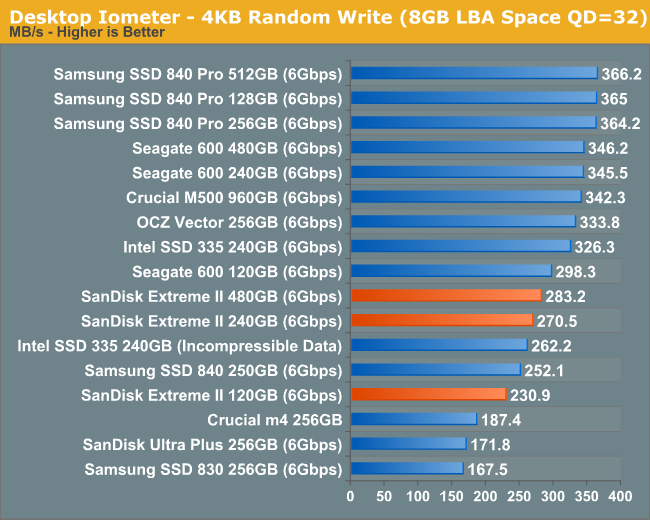
Sequential Read/Write Speed
To measure sequential performance I ran a 1 minute long 128KB sequential test over the entire span of the drive at a queue depth of 1. The results reported are in average MB/s over the entire test length. Sequential IO performance is very good on the Extreme II, effectively equalling the performance of Samsung's SSD 840 Pro.
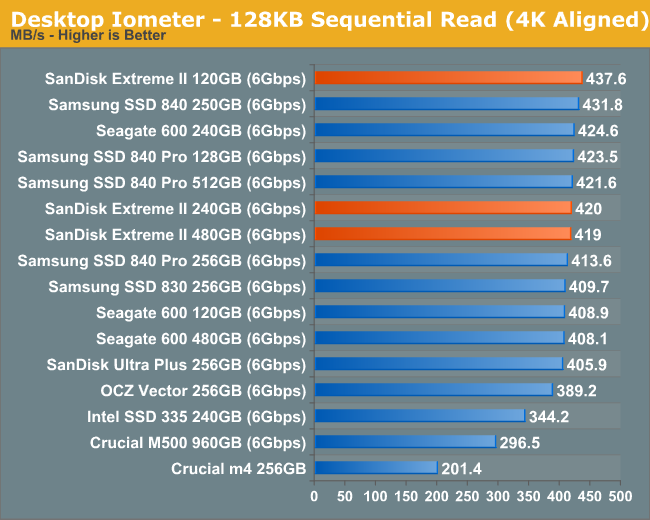
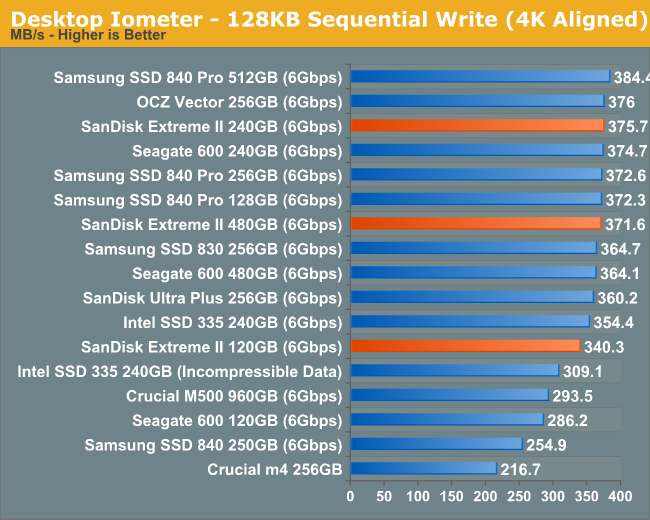
AS-SSD Incompressible Sequential Read/Write Performance
The AS-SSD sequential benchmark uses incompressible data for all of its transfers. The result is a pretty big reduction in sequential write speed on SandForce based controllers.
As a client focused drive, it's no susprise that the Extreme II does well in all of the sequential tests. I did notice consistently higher sequential read performance on the lower capacity Extreme II for some reason, but the gap isn't large enough to be significant. On the sequential write side, the 120GB drive is appreciably slower than the 240 and 480GB models simply because of the reduction in NAND die count.
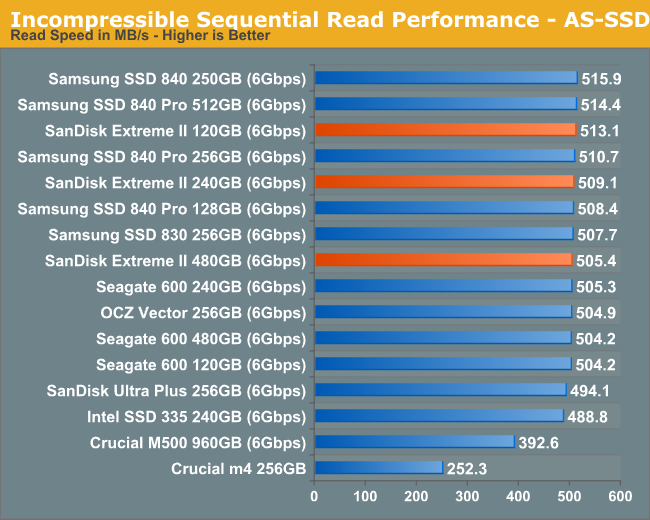
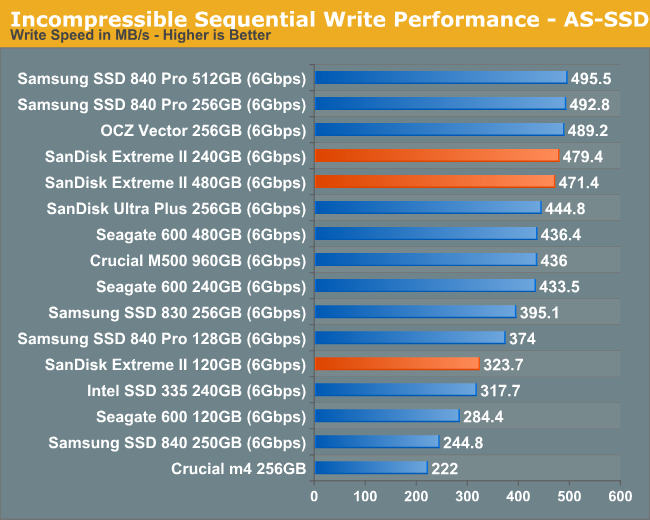










51 Comments
View All Comments
dsumanik - Tuesday, June 4, 2013 - link
The benches on this drive are good.....not great, and I don think the opening bias is necessary. Who runs any disk at capacity 24/7? Perhaps some people temporarily... But 24/7 drive full???Only a fool.
Kudos to sandisk for making a competitive offering, but please anandtech keep the bias out of the reviews....specially when it's not warranted.
Storage bench is great, but it's not the only metric.
Haswell is good, not great. But if your rocking a 2600k from 2 years ago? Meh.
Where are the legendary power savings? Why don't we have 4 ghz + skus? 8 cores? 64gb ram support? Quick sync degraded lol!! Good job on iris pro. Why can't I buy it and slap it into an enthusiast board?
Yet you read this review and the haswell review and come away feeling positive.
Real life:
Intel,
A mild upgrade in IPC, higher In use TDP, 2 year old CPU's are still competitive
Sandisk,
Mixed bag of results, on unproven firmware.
.
Death666Angel - Tuesday, June 4, 2013 - link
Why do you keep ignoring the Samsung 840 Pro with spare area increased when it comes to consistency. It seems to me to be the best drive around. And if you value and know about consistency it seems pretty straight forward to increase the spare area and you should have the abilities to do so as well.seapeople - Wednesday, June 5, 2013 - link
Agreed, it looks like a Samsung 840 Pro that's not completely full would be the performance king in every aspect - most consistent (check the 25% spare area graphs!), fastest in every test, good reliability history, and the best all around power consumption numbers, especially in the idle state which is presumably the most important.Yet this drive is virtually ignored in the review, other than the ancillary mention in all the performance benchmarks it still wins, "The SanDisk did great here! Only a little behind all the Samsung drives... and as long as the Samsung drives are completely full, then the SanDisk gets better consistency, too! The SanDisk is my FAVORITE!"
The prevailing theme of this review should probably be "The SanDisk gives you performance nearly as good as a Samsung at a lower price." Not, "OMG I HAVE A NEW FAV0RIT3 DRIVE! Look at the contrived benchmark I came up with to punish all the other drives being used in ways that nobody would actually use them in..."
Seriously, anybody doing all that junk with their SSD would know to partition 25% of spare area into it, which then makes the Samsung Pro the clear winner, albeit at a higher cost per usable GB.
FunBunny2 - Tuesday, June 4, 2013 - link
To the extent that "cloud" (re-)creates server-dense/client-thin computing, how well an SSD behaves in today's "client" doesn't matter much. Server workloads, with lots o random operations, will be where storage happens. Anand is correct to test SSDs under loads more server-like. As many have figured out, HDD in the enterprise are little different from consumer parts. "Cloud" vendors, in order to make money, will segue to "consumer" SSD. Thus, we do need to know how well they behave doing "server" loads; they will in any case. Clients will come with some amount flash (not necessarily even on current file system protocols).joel4565 - Tuesday, June 4, 2013 - link
Any word on whether this drive will be offered in a 960 GB capacity for a reasonable price in the near future?This looks like the best performing drive yet reviewed, but I doubt I will see that big of difference from my 120 GB Crucial M4 in day to day usage. I really don't think most of us will see a large difference until we go to a faster interface.
So unless this drastically change in the next few months, I think my next drive will be the Crucial M500 960GB. Yes it will not be as consistent or quite as fast as the SanDisk Extreme II, but I won't have to worry about splitting my files, or moving steam games from my 7200 rpm drive to the SSD if they have long load times.
clepsydrae - Wednesday, June 5, 2013 - link
Question for those more knowledgeable: I'm building a new DAW (4770k, win 8) which will also be used for development (Eclipse in linux). Based on earlier anandtech reviews I ordered a 128GB 840P Pro for use as the OS drive and eclipse workspace directory and the like. Reading this article, i'm not sure if I should return the 840P for the SanDisk... the 840P leads it in almost all the metrics except the one that is the most "real-world" and which seems to mimic what I'll be using it for (i.e. Eclipse.)Opinions?
bmgoodman - Wednesday, June 5, 2013 - link
I gave up on SanDisk after they totally botched TRIM on their previous generation drive. They did such a poor job admitting it and finally fixing it that it left a bad taste in my mouth. They'd have to *give* me a drive for me to try their products again.samster712 - Friday, June 7, 2013 - link
So would anyone recommend this drive over the 840pro 256? Im very indecisive about buying a new drive.Rumboogy - Thursday, July 11, 2013 - link
Quick question. You mentioned a method to create an unused block of storage that could be used by the controller by creating a new partition (I assume fully formatting it) and then deleting it. This assumes TRIM marks the whole set of LBAs that covered the partition as being available. What is the comparable procedure on a Mac? Particularly if you don't get TRIM by default. And if you do turn it would it work in this case? Is there a way to guarantee you are allocating a block of LBAs to non-use on the Mac?pcmax - Monday, August 12, 2013 - link
Would have been really nice to compare it to their previous gen the Extreme I?